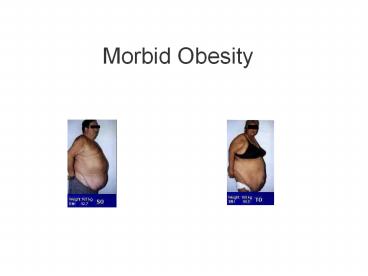Morbid Obesity Morbid Obesity- What is it? The term morbid - PowerPoint PPT Presentation
1 / 32
Title:
Morbid Obesity Morbid Obesity- What is it? The term morbid
Description:
Morbid Obesity Morbid Obesity- What is it? The term morbid obesity refers to patients who are 50-100%, or 100 pounds, above their ideal body weight. – PowerPoint PPT presentation
Number of Views:515
Avg rating:3.0/5.0
Title: Morbid Obesity Morbid Obesity- What is it? The term morbid
1
Morbid Obesity
2
Morbid Obesity- What is it?
- The term morbid obesity refers to patients who
are 50-100, or 100 pounds, above their ideal
body weight. Alternatively, a body mass index
(BMI) value greater than 39 may be used to
diagnose morbid obesity. - BMI ( Weight in Pounds x 703)
- (Height in inches x Height in inches)
Source National Institutes of Health
3
Facts about Morbid Obesity
- A chronic disease that afflicts approximately 9
million adult Americans. - That is over twice the size of the total
population with Alzheimers disease. - If the entire morbidly obese population lived in
one state, it would be the 12th state in
population. - The health effects associated with morbid obesity
are numerous and can be disabling.
Source American Obesity Association
4
Morbid Obesity
5
Co-morbidity
6
Cardiovascular System
- Chronic Venous Insufficiency
- Hypertension
- Hyperlipidemia
- Atherosclerosis
- Deep Vein Thrombosis
- Peripheral Vascular Disease
7
Digestive System
- Gastroesophageal Reflux Disease
- Gallbladder Disease
- Nonalcoholic Steatohepatitis
8
Endocrine System
- Diabetes (Type 2)
- Pancreatitis
9
Musculoskeletal System
- Osteoarthritis
- Rheumatoid Arthritis
- Sever¹s Disease
- Vertebral Disk Herniation
10
Nervous System
- Pseudotumor Cerebri
- Carpal Tunnel Syndrome
- Stroke
11
Reproductive System
- Infertility
- Menstrual Abnormalities
- Pregnancy Abnormalities
- Impotence
- Polycystic Ovarian Disease
- Neural Tube Birth Defects
12
Respiratory System
- Asthma
- Obesity Hypoventilation Syndrome
- Sleep Apnea
- Pulmonary Hypertension
13
Urinary System
- Urinary Stress Incontinence
- Gout
- Renal Disease
14
Integumentary System
- Hirsutism
- Cellulitis
- Fungal Skin Infections
- Panniculitis
15
Immune System
- Cancers (Breast, Prostate and Colon)
- Poor Healing of Wounds and Infection
16
Mass
17
Risk Management
18
Complications
19
Excessive/Unnecessary treatment
20
Pulmonary treatments
21
Specialty bed
22
Mobility
23
Toileting
24
Diabetic
25
Surgery
26
Dependent
27
Activities of daily living
- Preparation
- Shopping
- Housekeeping
- Errands
28
Caring
29
Follow-up
- Support
- Assistance
- Accountability
30
Feel supported
- Sticks with new diet
- Continues exercising
- Looses weight
31
Frustration
32
References
- American Obesity Association
- http//www.obesity.org/subs/fastfacts/morbidobesit
y.shtml - Association for Morbid Obesity Support
- http//www.obesityhelp.com/morbidobesity/m-surgery
types.phtml - National Institutes of Health
- http//www.nlm.nih.gov/medlineplus/ency/article/00
3102.htm































